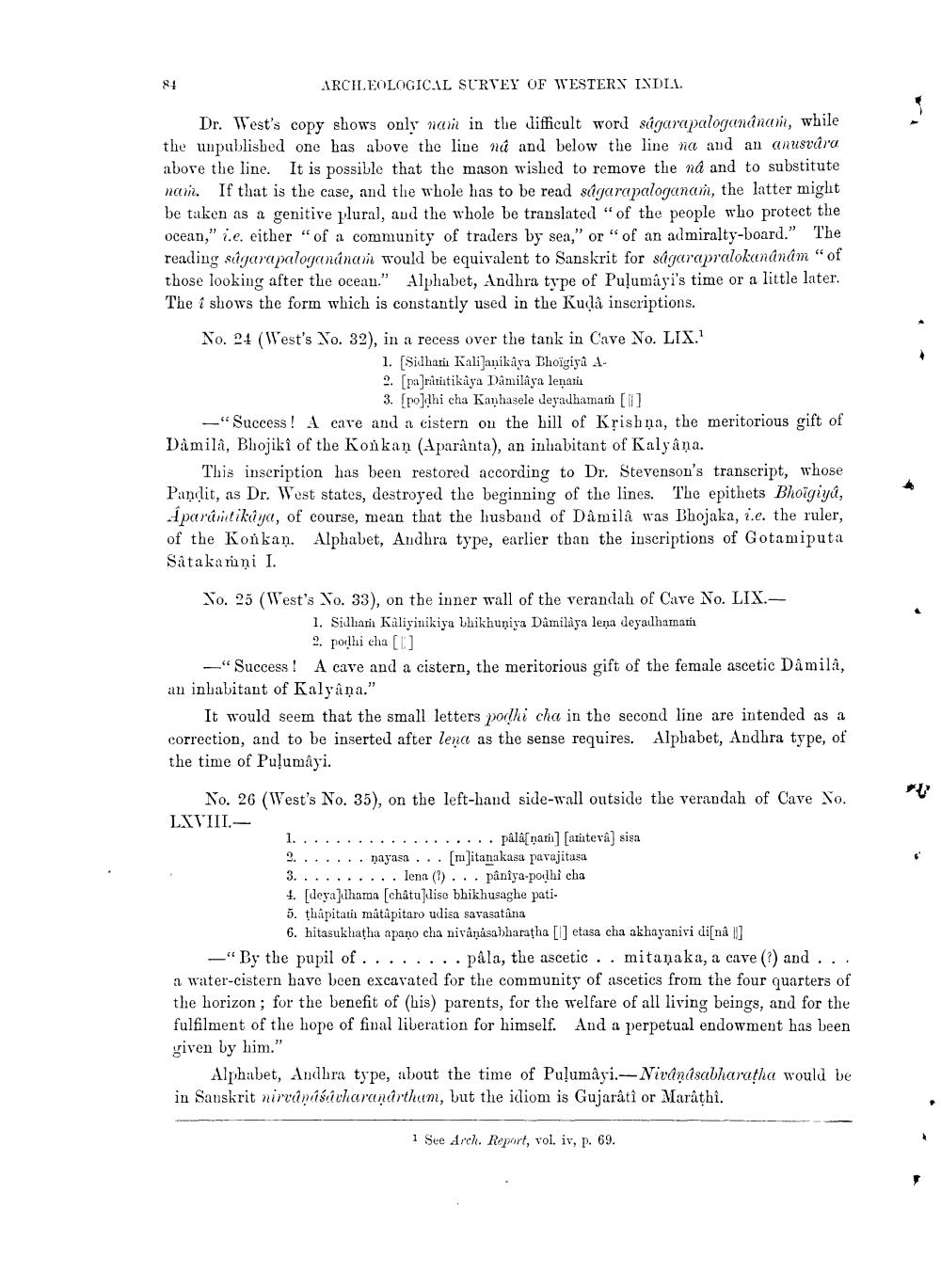________________
ARCHEOLOGICAL SURVEY OF WESTERN INDIA.
Dr. West's copy shows only wain in the difficult word sågarapalogandna, while the unpublished one has above the line na and below the line na and an anusvára above the line. It is possible that the mason wished to remove the nd and to substitute we. If that is the case, and the whole has to be read sågarapaloganam, the latter might be taken as a genitive plural, and the whole be translated "of the people who protect the ocean," i.e. either "of a community of traders by sea," or "of an admiralty-board." The reading sågarapalogandna would be equivalent to Sanskrit for adgarapralokanand "of those looking after the ocean." Alphabet, Andhra type of Pulumâyi's time or a little later. The shows the form which is constantly used in the Kuda inscriptions.
84
No. 24 (West's No. 32), in a recess over the tank in Cave No. LIX.1
1. [Sidhari Kalijanikaya Bhoïgiyâ A
2. [parâmitikaya Dâmilâya lenari
3. [po]dhi cha Kaphasele deyadhamari [||]
"Success! A cave and a cistern on the hill of Krishna, the meritorious gift of Damila, Bhojiki of the Konkan (Aparanta), an inhabitant of Kalyana.
This inscription has been restored according to Dr. Stevenson's transcript, whose Pandit, as Dr. West states, destroyed the beginning of the lines. The epithets Bloigiya, Aparántikaya, of course, mean that the husband of Dâmilâ was Bhojaka, i.e. the ruler, of the Konkan. Alphabet, Andhra type, earlier than the inscriptions of Gotamiputa Sâtakamni I.
No. 25 (West's No. 33), on the inner wall of the verandah of Cave No. LIX.1. Sidham Kaliyinikiya bhikhuniya Dâmilaya lena deyadhamam 2. podhi cha []
"Success! A cave and a cistern, the meritorious gift of the female ascetic Dâmilâ, an inhabitant of Kalyana."
It would seem that the small letters podhi cha in the second line are intended as a correction, and to be inserted after lena as the sense requires. Alphabet, Andhra type, of the time of Pulumayi.
No. 26 (West's No. 35), on the left-hand side-wall outside the verandah of Cave No. LXVIII.
1.
2.
3.
4. [deyathama [châtuliso bhikharaghe pati
5. thâpitam mâtâpitaro udisa savasatâna
6. hitasukhatha apano cha nivânasabharatha [] etasa cha akhayanivi di[nâ ||]
pâlâ[nam] [amtevâ] sisa [m]itanakasa parajitasa
nayasa
lena (?)... pânîya-podhi cha
-"By the pupil of. . . . .. pâla, the ascetic. . mitanaka, a cave (?) and . . . a water-cistern have been excavated for the community of ascetics from the four quarters of the horizon; for the benefit of (his) parents, for the welfare of all living beings, and for the fulfilment of the hope of final liberation for himself. And a perpetual endowment has been given by him."
Alphabet, Andhra type, about the time of Pulumayi.-Niedyabharatha would be in Sanskrit nirvydáźicharazdrthum, but the idiom is Gujarati or Marathi.
1 See Arch. Report, vol. iv, p. 69.
"U




